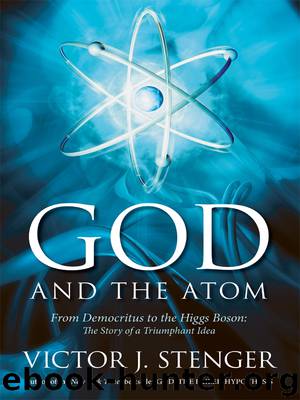God and the Atom by Victor J. Stenger

Author:Victor J. Stenger
Language: eng
Format: epub
Publisher: Prometheus Books
Published: 2013-03-13T16:00:00+00:00
We knew the world would not be the same. Few people laughed, few people cried, most people were silent. I remembered the line from the Hindu scripture, the Bhagavad-Gita. Vishnu is trying to persuade the Prince that he should do his duty and to impress him takes on his multi-armed form and says, “Now I am become Death, the destroyer of worlds.” I suppose we all thought that, one way or another.
—Robert Oppenheimer1
NUCLEI
Since 1932, it has been known that the nuclei of atoms are composed of protons and neutrons, generically referred to as nucleons. The proton carries an electric charge of +e, where e is the unit electric charge and the electron's charge is –e. The neutron is electrically neutral and is just slightly heavier than the proton. Each nucleon is over 1,830 times more massive than an electron, and so the masses of atoms are essentially contained in their nuclei.
The diameters of nuclei range from 0.8 femtometers for hydrogen to 15 femtometers for uranium, where 1 femtometer equals 10–15 meter. The diameter of the hydrogen atom is about 0.11 nanometer, while that of the uranium atom is 0.35 nanometer, where 1 nanometer equals 10–9 meter. So, roughly speaking, the nucleus of the atom is a million times smaller than the atom itself. Matter is, indeed, mostly empty space.
In chemical and nuclear reactions, the sum of the atomic numbers of the reactants does not change even though the reactants themselves can change. This follows from the principle of charge conservation: the total charge in a reaction is unchanged in the reaction.
Likewise, we observe a principle of nucleon number conservation: the total number of nucleons in a reaction is unchanged during the reaction. (Later this will be modified when we get to particle physics.)
In this chapter, all nuclear and subnuclear particles X will be designated with the notation ZXA, where Z is the charge in units of the unit electric charge (the atomic number in the case of nuclei) and A is the nucleon number, usually (but not always) the atomic weight to the nearest integer. X is the chemical symbol for the atom found in the periodic table, or the particle symbol in the case of subatomic particles.
In chapter 6, it was mentioned that Ernest Rutherford had transmuted nitrogen into oxygen by bombarding it with alpha rays. Although he did not recognize it at the time, the specific reaction was:
Download
This site does not store any files on its server. We only index and link to content provided by other sites. Please contact the content providers to delete copyright contents if any and email us, we'll remove relevant links or contents immediately.
The Lost Art of Listening by Michael P. Nichols(7403)
Why I Am Not A Calvinist by Dr. Peter S. Ruckman(4099)
The Rosicrucians by Christopher McIntosh(3465)
Wicca: a guide for the solitary practitioner by Scott Cunningham(3125)
Signature in the Cell: DNA and the Evidence for Intelligent Design by Stephen C. Meyer(3071)
Real Sex by Lauren F. Winner(2967)
The Holy Spirit by Billy Graham(2892)
To Light a Sacred Flame by Silver RavenWolf(2767)
The End of Faith by Sam Harris(2688)
The Gnostic Gospels by Pagels Elaine(2469)
Waking Up by Sam Harris(2389)
Nine Parts of Desire by Geraldine Brooks(2325)
Jesus by Paul Johnson(2309)
Devil, The by Almond Philip C(2280)
The God delusion by Richard Dawkins(2264)
Heavens on Earth by Michael Shermer(2234)
Kundalini by Gopi Krishna(2136)
Chosen by God by R. C. Sproul(2122)
The Nature of Consciousness by Rupert Spira(2044)
